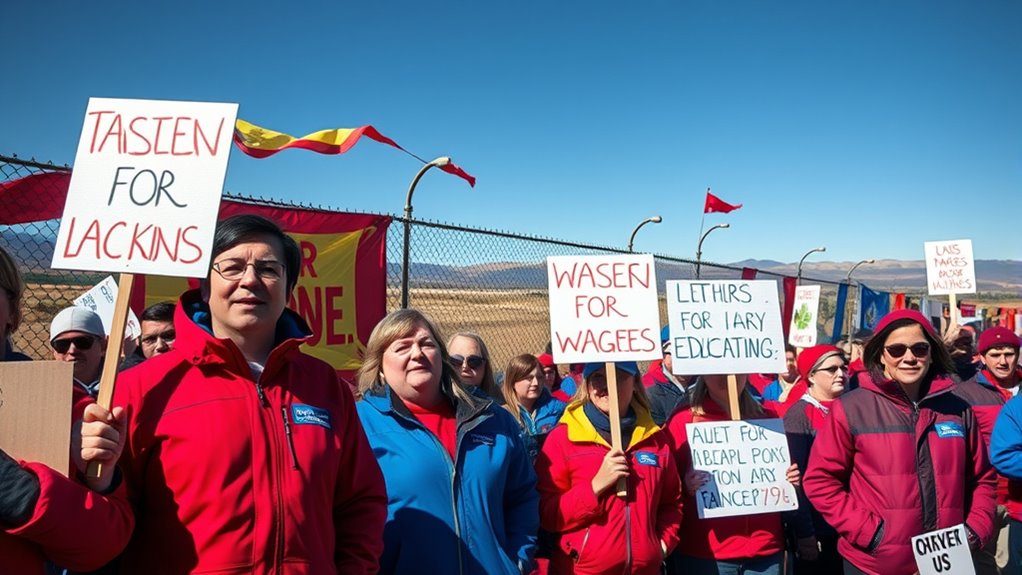The Alberta teachers’ strike happens because many educators are frustrated with stagnant wages, larger class sizes, and funding cuts that hurt school resources. They feel underappreciated and overworked, which affects the quality of education students receive. The strike also sparks debates about government priorities and education funding. If you want to understand how these issues could shape Alberta’s education future, there’s more you should explore.
Key Takeaways
- Teachers are striking for better pay, smaller class sizes, and improved resources due to funding cuts and rising workload.
- The strike highlights dissatisfaction with stagnant wages, overcrowded classrooms, and limited educational support.
- Disruptions impact students, parents, and communities, raising concerns over school closures and childcare challenges.
- The strike fuels political debates on education funding priorities, accountability, and fiscal responsibility.
- Long-term, the strike may influence future education policies, funding strategies, and government approaches in Alberta.

The Alberta teachers’ strike has disrupted classrooms across the province as educators protest for better pay, working conditions, and increased funding for public education. You might feel the frustration teachers are experiencing, as they aim to address issues that directly impact both their professional lives and the quality of education students receive. The core reason behind this strike stems from years of mounting concerns over stagnant wages that no longer keep pace with inflation, making it difficult for teachers to maintain their standard of living. Many teachers feel underappreciated and overworked, juggling larger class sizes, limited resources, and increased administrative demands without adequate compensation.
You may also notice that the strike is driven by broader concerns about working conditions. Teachers are advocating for smaller class sizes, better support staff, and improved access to classroom resources. They argue that these improvements are essential to providing students with a quality education, and that current conditions hinder their ability to teach effectively. The strike isn’t just about pay; it reflects a deep dissatisfaction with the overall environment in which teachers operate. Many educators are concerned that the government’s funding cuts over recent years have led to overcrowded classrooms and reduced educational services, ultimately affecting students’ learning experiences. Additionally, research indicates that adequate funding is crucial for maintaining quality education and teacher satisfaction.
The repercussions of this strike extend well beyond the classroom. Parents are caught in the middle, often facing sudden childcare challenges or disruptions to their routines. Schools may close temporarily or operate on limited schedules, which can strain working parents trying to balance their commitments. The strike also puts pressure on school boards and the provincial government to come to an agreement quickly, as prolonged disruptions threaten the stability of the education system. In some cases, this tension sparks debates about public funding priorities and government accountability, sparking broader discussions about the future of education in Alberta.
As you follow these developments, you might notice that the strike has also fueled political debates. Some argue that the government needs to prioritize education funding to retain skilled teachers, while others emphasize fiscal responsibility amidst economic challenges. The negotiations continue behind closed doors, but the pressure from teachers and their unions is undeniable. Ultimately, this strike highlights the urgent need for sustainable solutions that balance fair compensation for educators with responsible public spending. While the immediate goal is to improve conditions for teachers, the long-term impact could reshape Alberta’s approach to education funding and policy, affecting generations of students and educators to come.
Frequently Asked Questions
How Long Did the Alberta Teachers’ Strike Last?
You might be surprised to learn that the Alberta teachers’ strike lasted for approximately two weeks. During this period, teachers organized protests and negotiations to address issues like pay and working conditions. As a result, both sides worked intensively to reach an agreement. The strike’s duration impacted students, parents, and the community, highlighting the importance of resolving disputes promptly to minimize disruptions in education.
What Were Teachers Demanding During the Strike?
During the strike, you demanded better pay, improved working conditions, and more funding for education. You felt that your work was undervalued and wanted fair compensation for your efforts. You also pushed for smaller class sizes, updated resources, and increased support staff to enhance student learning. Your goal was to guarantee a healthier, more sustainable work environment while advocating for quality education for all students.
How Did Students and Parents Cope During the Strike?
You felt the strain as the strike dragged on, uncertain of what would come next. Parents scrambled to find alternative care, juggling work and unexpected schedules, while students faced days of missed lessons and mounting frustration. You searched for ways to keep learning alive—online resources, tutoring, or even informal study groups. The uncertainty lingered, but your resilience kept pushing through, hoping for an end to the disruption.
Were There Any Legal Actions Taken Against Strikers?
Yes, legal actions were taken against some teachers who participated in the strike. The government and school boards filed lawsuits claiming violations of employment agreements and unpaid wages. Some teachers faced disciplinary measures or legal consequences for striking without proper authorization. You might see this as a way to enforce contractual obligations, but it also sparked debates about workers’ rights and the legality of strike actions in the education sector.
What Measures Were Implemented to Prevent Future Strikes?
To prevent future strikes, policymakers introduced measures like improved communication channels between teachers and administration, increased funding for education, and clearer contractual agreements. They also emphasized conflict resolution training and established dispute resolution processes to address issues promptly. You should stay informed about these policies, participate in consultations, and advocate for ongoing dialogue to guarantee your concerns are heard and addressed proactively, reducing the likelihood of future disruptions.
Conclusion
As you watch teachers walk out, remember they’re like the roots of a mighty tree, holding up the future. When they strike, it’s a sign that something needs to change—like a branch bending under too much weight. The 10,000 students affected show how deeply this issue runs. Your support can help nurture growth and stability, ensuring that, like strong roots, education remains resilient and vibrant for generations to come.










